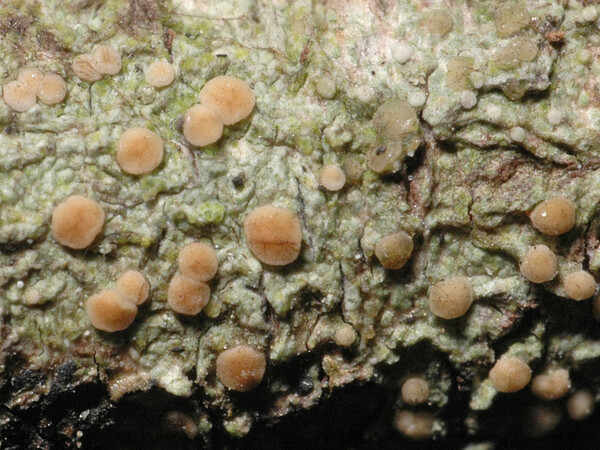Biatora meiocarpa (Nyl.) Arnold
Verh. zool.-bot. Ges. Wien, 37: 141, 1887. Basionym: Lecidea meiocarpa Nyl. - Flora, 59: 577, 1876.
Synonyms: Biatora meiocarpa (Nyl.) Arnold; Lecidea meiocarpa Nyl.; Lecidea minuta auct. non (Nyl.) Nyl.
Description: Thallus crustose, rimose-areolate or small-areolate, sometimes partly endosubstratic, pale beige to greyish green. Apothecia biatorine, rounded to rarely deformed-tuberculate, sessile and constricted at base, 0.45-0.6 mm across, with an orange brown to brown, epruinose, flat to slightly convex disc, and a thin, usually paler, sometimes indistinct, finally excluded proper margin. Proper exciple colourless throughout to orange-brown in innermost part, laterally 30-75 µm wide, of radiating hyphae with 1.5-3.5 µm thick lumina, the apical cells 2-6 µm wide; epithecium scarcely differentiated from the hymenium, colourless or rarely with orange-brown droplets; hymenium colourless to pale golden brown, 40-55 µm high; paraphyses simple or weakly branched and anastomosing, 0.7-1.2 µm thick at mid-level, the apical cells 1.5-4 µm wide; subhymenium distinct, 20-60 µm high; hypothecium colourless, 35-120 µm high. Asci 8-spored, clavate, with a K/I+ blue apical dome penetrated by a narrow, K/I- apical cushion surrounded by a narrow, deeply K/I+ blue zone, the wall K/I- but surrounded by an I+ red-brown, K/I+ blue outer layer, the ocular chamber relatively small, Biatora-type. Ascospores 1-celled (rarely a few 1-septate), hyaline, (7.5-)10-15(-17) x 3-4(-5) µm. Pycnidia globular, semi-immersed, c. 100 µm in diam., the wall colourless to pale brown. Conidia broadly filiform, 25-35(-45) x 1-1.8 µm. Photobiont chlorococcoid. Spot tests: thallus K-, C-, KC-, P-. Chemistry: without lichen substances.
Growth form: Crustose
Substrata: bark
Photobiont: green algae other than Trentepohlia
Reproductive strategy: mainly sexual
Commonnes-rarity: (info)
Alpine belt: absent
Subalpine belt: absent
Montane belt: very rare
Dry submediterranean belt: absent
Humid submediterranean belt: absent
Padanian area: absent
pH of the substrata:
1 2 3 4 5
Solar irradiation:
1 2 3 4 5
Aridity:
1 2 3 4 5
Eutrophication:
1 2 3 4 5
Poleotolerance:
0 1 2 3
Altitudinal distribution:
1 2 3 4 5 6
Rarity
absent
extremely rare
very rare
rare
rather rare
rather common
common
very common
extremely common
Loading data...
Occurrence data
Predictive map
Growth form: Crustose
Substrata: bark
Photobiont: green algae other than Trentepohlia
Reproductive strategy: mainly sexual
Commonnes-rarity: (info)
Alpine belt: absent
Subalpine belt: absent
Montane belt: very rare
Dry submediterranean belt: absent
Humid submediterranean belt: absent
Padanian area: absent
pH of the substrata:
| 1 | 2 | 3 | 4 | 5 |
Solar irradiation:
| 1 | 2 | 3 | 4 | 5 |
Aridity:
| 1 | 2 | 3 | 4 | 5 |
Eutrophication:
| 1 | 2 | 3 | 4 | 5 |
Poleotolerance:
| 0 | 1 | 2 | 3 |
Altitudinal distribution:
| 1 | 2 | 3 | 4 | 5 | 6 |
Rarity
absent
extremely rare
very rare
rare
rather rare
rather common
common
very common
extremely common
Loading data...
Occurrence data
Predictive map







